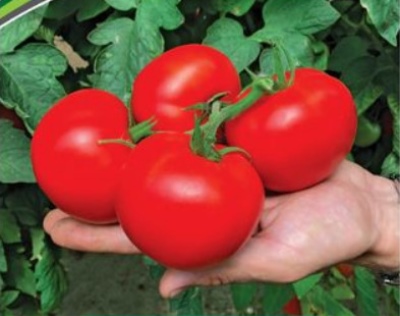
- Authors: Blokin-Mechtalin V.I.
- Year of approval: 2020
- Name synonyms: Barika F1
- Category: hybrid
- Growth type: indeterminate
- Appointment: universal
- Ripening period: mid-season
- Ripening time, days: 95-100
- Growing conditions: for open ground, for film greenhouses
- Transportability: high
Barika is one of the new varieties of tomatoes of the indeterminate category. It is grown both in private dachas and on farms for sale to the population. Hybrid tomato Barika (synonym - Barika F1) for universal purposes is suitable for cultivation in open spaces and in greenhouses, used for fresh consumption, for processing and whole-fruit conservation.
Breeding history
The authorship belongs to V.I. Blokin-Mechtalin. The year of admission to cultivation is 2020.
Description of the variety
Tall bushes are covered with dark green leaves with a carved plate. Tomato lays the first inflorescence above 8-9 leaves, all subsequent ones - after 2-3 leaves. Yellow flowers give a good percentage of ovary, but the help of bumblebees and bees increases their number, as does the preparation "Ovary". Tomatoes develop on an articulated stalk.
The main qualities of the fruit
Medium-sized fruits are covered with a smooth glossy skin of medium thickness. The shape is round, slightly ribbed, each fruit weighs about 140 g. Unripe tomatoes are colored green, at the stage of technical ripeness they are bright red. Ripe tomatoes have good keeping quality, transportation and a tendency to ripening, which makes it possible to harvest unripe fruits when cold weather sets in, which will reach ripeness in storage.
Taste characteristics
Barika has a pleasant sweet taste without sourness.
Ripening and fruiting
The hybrid is characterized as mid-ripening: the ripening period ranges from 95 to 100 days, although this is very conditional. The timing is influenced by many factors: from weather parameters to compliance with agricultural practices. Harvesting dates are quite extended - July-August.
Yield
Tomato Barika appeared on gardeners' plots quite recently, but the yield declared by the originator is high - from 15.5 to 16.8 kilograms per square meter. There are no real statistics on yield yet, but in any case, fruiting always depends on growing methods and adherence to agricultural techniques.
The timing of planting seedlings and planting in the ground
Sowing for seedlings is carried out in the third decade of April or early May. Seedlings are planted in the ground in May.

Growing tomato seedlings is an extremely important process, because it largely depends on whether the gardener will be able to harvest at all. All aspects must be taken into account, from seedbed preparation to planting in the ground.
Landing scheme
When planting, observe the recommended plant density - 4 pieces per square meter. The optimal distance between the bushes is 50x50 cm.

Growing and care
Growing indeterminate tomato Barik is not much different from the cultivation of any other categories: undersized, medium-sized, tall.It is grown in seedlings, but with only one difference - the sowing of seeds is carried out 10-12 days earlier. Gardeners around the world love indeterminate varieties for their unique ability to grow indefinitely and inflorescence. But the same feature makes certain agrotechnical requirements.
Plants of this type have a large vegetative mass and yield load, therefore, they need more nutrients, as well as the cost of installing trellises and fertilizers. The soil for growing indeterminate tomatoes is prepared in advance, choosing the previous crops, if the hybrid is planted in open ground. These are garlic, onions, cabbage, cucumbers, legumes, corn, green manure.
Cannot be planted after nightshades. A bad neighborhood will be the location of the crop next to the potatoes, since they are prone to the same diseases. In autumn, the soil is dug up with organic matter, superphosphate, potassium sulfate. The applied fertilizers will nourish the plants in the second half of the summer. In spring, the soil is also enriched with organic matter and mineral fertilizers, which the young seedlings will feed on.
After planting, standard activities are carried out: watering, weeding, pinching, feeding, preventive treatments. Formation of a bush in 1-2 shoots is obligatory. It is most convenient to plant the plants in trenches, and when the shoots grow well, hilling is carried out, which allows the hybrid to build up a more powerful root system.
As a result of several hilling, the plants are already growing on the ridge, and irrigation along the furrows leaves the stems dry, which is a good prevention of fungal diseases. Top dressing is carried out several times per season, usually 3-4. They use infusions of mullein, fermented compositions of nettle and weeds with the addition of grain residues, complex mineral fertilizers, which include potassium, phosphorus, nitrogen substances.




A plant needs different micronutrients at each stage of growth. All fertilizers can be divided into two groups: mineral and organic. Folk remedies are often used: iodine, yeast, bird droppings, eggshells.
It is important to observe the rate and period of feeding. This also applies to folk remedies and organic fertilizers.
Disease and pest resistance
Barika has a fairly strong immune system. Tomato is resistant to late blight, excellent resistance to tobacco mosaic virus (TMV), fusarium.


Resistant to adverse weather conditions
An adult plant tolerates temporary drought and temperature changes well.
Growing regions
The hybrid is rapidly spreading in such regions and regions as the Northern and North-Western districts, the Central region, as well as the Volgo-Vyatka, TsChO, North Caucasian, Middle Volga, Lower Volga regions. In addition to these areas, Barika can be grown in the Urals, in all regions of Siberia: West Siberian, East Siberian, Far Eastern districts.

























































































